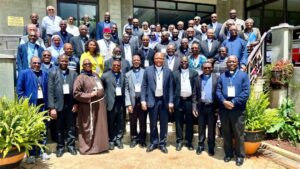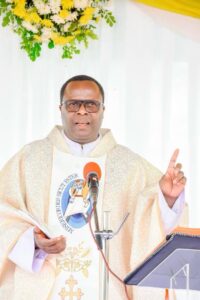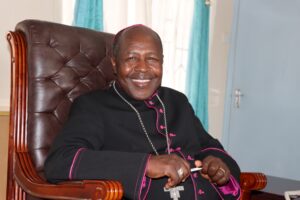ZAMBIA: Auxiliary Bishop of Chipata, Titular Bishop of Nachingwea: Bishop Benjamin Phiri Explains How

Bishop Phiri
Part two of the serialization of Rt. Rev. Benjamin Phiri, Auxiliary Bishop of Chipata
Rt. Rev. Benjamin Phiri, the Auxiliary Bishop of Chipata was ordained a priest on 14th September 1986. On 15th January 2011, the Holy Father Pope Emeritus Benedict XVI appointed him Auxiliary Bishop of Chipata and at the same time Titular Bishop of Nachingwea, Tanzania.
During his 14 years of his service as a priest of Chipata Diocese, Bishop Phiri served as a curate in Mbwindi Parish while at the same time a Vocation Promoter for the Diocese. He became a parish priest in Chadiza in 1988 and later in-charge of Chikungu Catechetical Training Centre between 1990 and 1996 when the then Bishop Chipata, Rt. Rev. Medardo Joseph Mazombwe asked him to go to Rome for further studies to specialize in Canon Law.
“When I came back in 2002, Rt. Rev. Medardo Mazombwe had been transferred to Lusaka as Archbishop (where he later became Cardinal). The then Apostolic Administrator who later became Bishop of Chipata, Rt. Rev. George Lungu informed me that the Bishops Conference requested my services and that I go to Lusaka to work for the Conference as National Pastoral Coordinator and Deputy Secretary General,” Bishop Phiri explained.
He worked at the Secretariat from 2002 to 2004 when the Conference asked him to serve as Rector of St. Dominic Theological Major seminary where he stayed until his appointment to episcopate.
Who is an Auxiliary Bishop?
There are three types of Bishops; the Diocesan Bishop who is either an Archbishop or Bishop to a particular archdiocese or diocese. An archdiocese in Canonical terms is called a Metropolitan See, which has other (suffragan) dioceses under it for the purpose of organization and good order. A Metropolitan See exists for other jurisdiction reasons such as reference point to the diocesan tribunal. The diocesan tribunal refer its cases when there is need for an appeal to the Metropolitan See, which acts as an Appeal Tribunal.
The Diocesan Bishop or Archbishop is the Local Ordinary of a Diocese and has the title of that particular Diocese. For instance, in the case of Chipata Rt. Rev. George Cosmas Lungu is the Bishop of Chipata, this implies that the Title of Bishop Lungu is to the Diocese of Chipata.
The second type of Bishop is the Coadjutor Bishop. Coadjutor comes from Latin word meaning to rule together with, therefore a Coadjutor Bishop is a bishop who is helping a Diocesan Bishop and has the right of succession. When the bishop he is helping leaves the seat, automatically the Coadjutor Bishop succeeds him without any special ceremony as such. He automatically becomes the Bishop of that Diocese.
The third type of Bishop is the Auxiliary Bishop who for special reasons is appointed to help the Diocesan Bishop. Unlike the Coadjutor Bishop, he does not have the right to succession. An Auxiliary Bishop, instead, is usually given a Diocese which is just by title (Titular Bishop). The reason being that one cannot be a Bishop without a Diocese; every Bishop must have a diocese. Therefore, the bishops who are performing special functions like an auxiliary bishop, a nuncio or those working at the Roman Curia must be given a diocese which they only possess by name.
Canonically an Auxiliary Bishop is supposed to be the chief adviser to the Diocesan Bishop. He is supposed to give whatever guidance and help as the Bishop may require. The Diocesan Bishop is however not obliged to ask the Auxiliary Bishop and have clearance from him every time unlike the case with the coadjutor Bishop. Although it is recommended that the Diocesan Bishop does not ignore easily the advice or counsel of the Auxiliary Bishop, he is not obliged to take it.
For how long will an Auxiliary Bishop serve in a diocese? the answer is for as long as the pope requires his services in that Diocese.
Bishop Phiri’s Special Relation with Tanzania
When he was appointed Auxiliary Bishop of Chipata in 2011, Bishop Phiri also became the Titular Bishop of Nachingwea Diocese. A titular Diocese is a diocese which existed before but for whatever reason has been supressed and does not exist anymore. Sometimes a diocese is suppressed because they want to create two dioceses or it has just been phased out or changed name. Although the diocese does not exist anymore, it is documented as a diocese in the Church. So when one is appointed a Titular Bishop, they give him that Diocese because it doesn’t exist anymore but was an actual diocese.
The Diocese of Nachingwea was erected on 5th August 1963, it was a territorial Abbey of Ndanda (Currently Mtwara Diocese). On 17th October 1986, it lost territory when the Diocese of Tunduru-Masasi was erected. On the same day, Nachingwea changed name to Lindi Diocese meaning that Nachingwea Diocese was suppressed and two new dioceses created – the Dioceses of Lindi and Tunduru-Masasi. Vatican officially established the Titular See of Nachingwea in January 2009 and two years later, its first Titular Bishop, Benjamin S. Phiri was appointed on 15th January 2011.
∽End∽
By Pamela Adinda, AMECEA Online News


